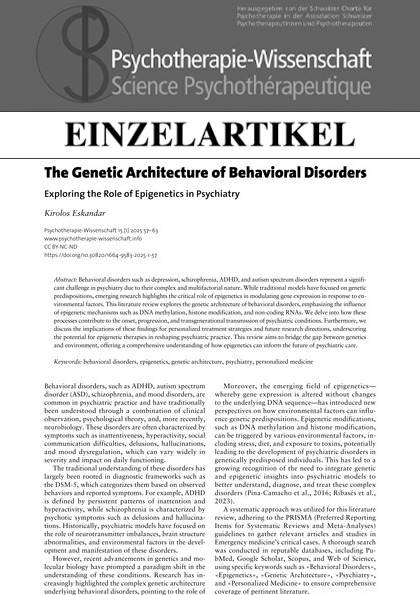The Genetic Architecture of Behavioral Disorders
Exploring the Role of Epigenetics in Psychiatry
DOI:
https://doi.org/10.30820/1664-9583-2025-1-57Schlagworte:
disturbi comportamentali, epigenetica, architettura genetica, psichiatria, medicina personalizzataAbstract
Behavioral disorders such as depression, schizophrenia, ADHD, and autism spectrum disorders represent a significant challenge in psychiatry due to their complex and multifactorial nature. While traditional models have focused on genetic predispositions, emerging research highlights the critical role of epigenetics in modulating gene expression in response to environmental factors. This literature review explores the genetic architecture of behavioral disorders, emphasizing the influence of epigenetic mechanisms such as DNA methylation, histone modification, and non-coding RNAs. We delve into how these processes contribute to the onset, progression, and transgenerational transmission of psychiatric conditions. Furthermore, we discuss the implications of these findings for personalized treatment strategies and future research directions, underscoring the potential for epigenetic therapies in reshaping psychiatric practice. This review aims to bridge the gap between genetics and environment, offering a comprehensive understanding of how epigenetics can inform the future of psychiatric care.
Downloads
Veröffentlicht
Zitationsvorschlag
Ausgabe
Rubrik
Lizenz
Copyright (c) 2025 Kirolos Eskandar

Dieses Werk steht unter einer Creative Commons Namensnennung - Nicht-kommerziell - Keine Bearbeitung 3.0 International -Lizenz.
Diese Zeitschrift bietet freien Zugang (Open Access) zu ihren Inhalten, entsprechend der Grundannahme, dass die freie öffentliche Verfügbarkeit von Forschung einem weltweiten Wissensaustausch zugutekommt.
Autor:innen, die in dieser Zeitschrift publizieren möchten, stimmen den folgenden Bedingungen zu:
- Die Autor:innen behalten das Copyright und erlauben der Zeitschrift die Erstveröffentlichung unter einer Creative Commons Namensnennung Lizenz, die es anderen erlaubt, die Arbeit unter Nennung der Autor:innenschaft und der Erstpublikation in dieser Zeitschrift zu verwenden (gemäß der Creative Commons Attribution-NonCommercial-NoDerivs 3.0 DE-Lizenz).
Die Autor:innen können zusätzliche Verträge für die nicht-exklusive Verbreitung der in der Zeitschrift veröffentlichten Version ihrer Arbeit unter Nennung der Erstpublikation in dieser Zeitschrift eingehen (z.B. sie in Sammelpublikation oder einem Buch veröffentlichen).


